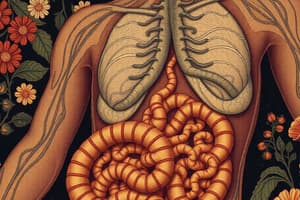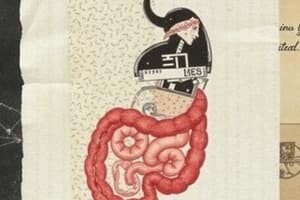Podcast
Questions and Answers
What is the primary function of the alimentary canal?
What is the primary function of the alimentary canal?
- To break down food completely
- To absorb nutrients into the bloodstream
- To transport food from the mouth to the rectum (correct)
- To produce enzymes for digestion
What defines a tissue in the context of biological organization?
What defines a tissue in the context of biological organization?
- A system of interconnected organ systems
- A group of organs working together
- A collection of cells performing the same function (correct)
- An individual cell carrying out all functions
Which of the following systems is responsible for circulation in the human body?
Which of the following systems is responsible for circulation in the human body?
- Excretory system
- Circulatory system (correct)
- Digestive system
- Respiratory system
Enzymes in the digestive system are produced by which type of organs?
Enzymes in the digestive system are produced by which type of organs?
What is the collective name for systems like the skeletal and muscular systems that facilitate movement?
What is the collective name for systems like the skeletal and muscular systems that facilitate movement?
Which part of the digestive system is NOT included in the alimentary canal?
Which part of the digestive system is NOT included in the alimentary canal?
What primary process does digestion help accomplish in the body?
What primary process does digestion help accomplish in the body?
Which organ is primarily responsible for producing bile?
Which organ is primarily responsible for producing bile?
Where does the primary absorption of nutrients take place in the digestive tract?
Where does the primary absorption of nutrients take place in the digestive tract?
What role does the liver play in the metabolism of glucose?
What role does the liver play in the metabolism of glucose?
Which substances are absorbed into the blood throughout the length of the small intestine?
Which substances are absorbed into the blood throughout the length of the small intestine?
What is the chief product formed from the excess nitrogen resulting from amino acid metabolism in the liver?
What is the chief product formed from the excess nitrogen resulting from amino acid metabolism in the liver?
Which process describes the conversion of digested nutrients into body substances?
Which process describes the conversion of digested nutrients into body substances?
What is the primary role of enzymes in the body?
What is the primary role of enzymes in the body?
At what temperature range do enzymes perform best?
At what temperature range do enzymes perform best?
Which of the following statements about enzymes is true?
Which of the following statements about enzymes is true?
What is the role of saliva in digestion?
What is the role of saliva in digestion?
Where does the digestion of carbohydrates mainly occur?
Where does the digestion of carbohydrates mainly occur?
What does the liver produce for digestion?
What does the liver produce for digestion?
How long does food typically remain in the stomach?
How long does food typically remain in the stomach?
Which part of the digestive system absorbs water from undigested food?
Which part of the digestive system absorbs water from undigested food?
Flashcards are hidden until you start studying
Study Notes
The Human Body: Organization and Systems
- Organisms, from single-celled amoebas to complex humans, have structures enabling survival.
- Multicellular organisms exhibit increasing complexity, with cells specializing into tissues, tissues into tissue systems, and so on, ultimately forming organ systems.
- Ten well-developed organ systems in the human body include digestive, respiratory, circulatory, excretory, reproductive, skeletal, muscular, nervous, integumentary (skin), and endocrine systems. These are categorized into energy/transport/reproduction, movement, and control/coordination groups.
The Digestive System: Overview
- Digestion breaks down complex food into absorbable substances.
- The alimentary canal (9-meter long) facilitates this process using enzymes.
- Enzymes are biocatalysts that speed up reactions without being consumed. They are proteins, function optimally at 35-40°C, are specific to substrates, reusable, and accelerate reaction rates.
Digestive System: Components and Functions
- Alimentary Canal: Mouth, esophagus, stomach, small intestine, large intestine.
- Associated Glands: Salivary glands, liver, pancreas.
- Mouth: Teeth break down food, salivary glands secrete saliva aiding digestion and swallowing; tongue aids in food manipulation and taste.
- Esophagus: Transports food to the stomach.
- Stomach: Muscular pouch; gastric juice (hydrochloric acid) partially digests proteins. Food remains for approximately four hours.
- Small Intestine: Long, coiled; complete digestion occurs over 4-5 hours with enzymes from the pancreas and liver (bile from liver, stored in gallbladder).
- Large Intestine: Absorbs water; stores undigested waste (feces) for about 12 hours before elimination through the anus.
Digestion of Nutrients
- Carbohydrates: Digested in the mouth, stomach, duodenum, and ileum.
- Proteins: Digested in the stomach and small intestine, with enzyme participation.
- Fats: Digested in the duodenum with the help of bile.
Absorption and Assimilation
- Absorption: Movement of substances across cell layers into the body's internal environment; primarily in the ileum. Water, minerals, vitamins, simple sugars, and amino acids are absorbed.
- Assimilation: Conversion of absorbed nutrients into body substances. The liver plays a crucial role:
- Glucose: Converted to glycogen for storage; converted back to glucose as needed; excess stored as fat.
- Fats: Used in the manufacture of fatty substances like cholesterol.
- Amino Acids: Used to build proteins; excess converted to urea (a nitrogenous waste product) or glucose.
Studying That Suits You
Use AI to generate personalized quizzes and flashcards to suit your learning preferences.





